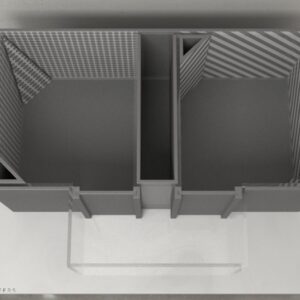Size | Force (G) |
1.65 | 0.008 |
2.36 | 0.02 |
2.44 | 0.04 |
2.83 | 0.07 |
3.22 | 0.16 |
3.61 | 0.4 |
3.84 | 0.6 |
4.08 | 1 |
4.17 | 1.4 |
4.31 | 2 |
4.56 | 4 |
4.74 | 6 |
4.93 | 8 |
5.07 | 10 |
5.18 | 15 |
5.46 | 26 |
5.88 | 60 |
6.1 | 100 |
6.45 | 180 |
6.65 | 300 |
$749.00
Von Frey filaments are a set of calibrated nylon fibers used in sensory testing to evaluate tactile sensitivity and pain threshold in humans and animals. They come in various diameters and are applied to the skin to determine the minimum force required to elicit a response, such as a withdrawal reflex. These filaments are commonly employed in neurological examinations and research to assess sensory function and detect abnormalities in touch perception.
Set of 20 filaments.

MazeEngineers empowers preclinical neuroscience research with meticulously designed, customizable behavioral apparatuses. From manual classic mazes to fully automated smart systems, we provide the tools scientists need to capture high-quality, reproducible data for studies on learning, memory, anxiety, and depression.

bool(false)

bool(false)

The Von Frey Filaments set includes an entire set of 20 filaments designed for precise mechanical stimulation in research applications.
These filaments are ideal for assessing pain thresholds and sensory responses in various subjects, ensuring accurate and reliable results. Easy to use and durable, this set is essential for any laboratory conducting sensory testing.
Size | Force (G) |
1.65 | 0.008 |
2.36 | 0.02 |
2.44 | 0.04 |
2.83 | 0.07 |
3.22 | 0.16 |
3.61 | 0.4 |
3.84 | 0.6 |
4.08 | 1 |
4.17 | 1.4 |
4.31 | 2 |
4.56 | 4 |
4.74 | 6 |
4.93 | 8 |
5.07 | 10 |
5.18 | 15 |
5.46 | 26 |
5.88 | 60 |
6.1 | 100 |
6.45 | 180 |
6.65 | 300 |
Presenting a groundbreaking leap forward in the realm of sensory evaluation instrumentation, our meticulously crafted ensemble of 20 monofilaments, colloquially denoted as Von Frey hairs, stands as a pinnacle of refinement and innovation in comparison to the esteemed Semmes Weinstein monofilament set. This latest iteration represents a culmination of advanced engineering, featuring the integration of retractable filaments—a technological breakthrough engineered to safeguard filament integrity while concurrently enhancing the portability and usability of these instruments. This innovation empowers investigators to seamlessly incorporate these cutting-edge tools into their dynamic research endeavors, whether in clinical or experimental settings.
Drawing upon the foundational principles entrenched by the Semmes Weinstein set, our meticulously engineered monofilaments boast an intricate interplay between physical force and perceived sensation, thereby manifesting an approximate logarithmic scale of actual force meticulously aligned with a linear scale of perceived intensity. This harmonious synchronization underscores the unparalleled precision and reliability imbued within our sensory evaluation arsenal, facilitating nuanced assessments across a spectrum of sensory pathologies, ranging from hyper- to hypo-aesthesia.
The inherent versatility and comprehensiveness of our monofilament set are epitomized by its meticulous subdivision into 20 distinct probes, each meticulously tailored to address the intricate sensitivities of various anatomical regions. From the intricate tactile discrimination of the foot to the subtle nuances of the lip and cheek, each subset is curated with meticulous attention to detail, facilitating holistic diagnostic evaluations that leave no sensory domain unexplored.
In the realm of translational research involving rodent models, where the assessment of sensory function assumes paramount importance in unraveling underlying neural mechanisms and evaluating therapeutic interventions, the utilization of the Touch Test™ Sensory Evaluator on the plantar surfaces of a rodent’s paw emerges as an invaluable tool. By monitoring reflexive paw withdrawal—a reliable surrogate marker of sensory perception—researchers can effectively gauge sensory responsiveness and glean insights into neural circuitry and sensory processing. Furthermore, the seamless availability of replacement filaments ensures uninterrupted usage, empowering researchers to pursue rigorous investigations without logistical impediments, thereby advancing the frontiers of scientific inquiry and therapeutic innovation.

When a fiber of specified length and diameter is pressed perpendicularly against the skin, the applied force increases progressively as the researcher advances the probe until the fiber reaches its bending point. Subsequent advancement results in further bending of the fiber but does not escalate the force of application. This fundamental principle enables researchers to consistently apply a reproducible force to the skin surface using a handheld probe, maintaining a broad tolerance range.
Note: Due to the inherent physical properties of the filament material, it is advisable to operate within a temperature range of 18°C to 24°C and a humidity range of 60% to 80% to ensure optimal reliability of results.
| Weight | 1.10 lbs |
|---|---|
| Dimensions | 20.32 × 22.86 × 7.62 cm |
There are no questions yet. Be the first to ask a question about this product.